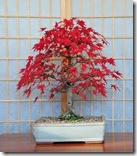 Overview
Overview
The Japanese Maple Bonsai tree is one of the most popular of all bonsai trees. It is considered a perfect specimen for "bonsai beginners," as it is strikingly beautiful, but requires little care. While all Japanese Maple Bonsais produce stunning red and gold leaves in the fall, the more than 300 varieties of Japanese Maple Bonsai come in a variety of colors, sizes, and foliage types.
The Japanese Maple Bonsai
These distinctive trees grow to a height of about 3 feet. If you buy one from a nursery, select one with a trunk that is at least four to five inches in diameter. You can train your Japanese Maple Bonsai to grow in several different "styles" or shapes. This tree is ideal for shallow container gardening.
Care
The roots of the Japanese Maple Bonsai tree must remain moist, so during the summer months, it needs a partially shady environment. During the rest of the year, it will thrive in full to partial sun as long as it is protected during high winds and frost. Mulch your Japanese Maple Bonsai well in cold weather, and move it indoors or into a greenhouse.
Pruning
Spring is the time to prune your Japanese Maple Bonsai. Pinch back new shoots that have four or more nodes. Leave the shoots a half inch longer than you want them when pruning, to allow for dieback (when tips or shoots die due to disease or damage). Apply pruning paste at the site of each cut. Non-asphalt-based pruning paste will protect against your tree against disease.
Feeding
Repot your Japanese Maple Bonsai every other year for the first ten years, using equal parts loam, peat moss, and coarse sand. Cut the roots to half their size each time you report. Fertilize your tree each month from late winter to early spring, but do not feed for two months after repotting or during the height of summer.
Watering
Check your tree each day for moisture content. Keep the soil moist, but not wet. If the soil is allowed to dry out, leaf burn may result. If the soil cannot drain adequately, root rot may occur.
Problems
Mildew and root rot are the most common problems you’ll encounter with your Japanese Maple Bonsai tree. You can avoid these conditions by making sure your tree’s soil can drain well. Aphids are the only common pest that is frequently attracted to Japanese Maple Bonsais. If aphids are a problem, try adding a small amount of dishwashing liquid to a spray bottle of water and spray liberally. If this doesn’t solve the problem, an insecticidal soap will do the trick.

Deprecated: strpos(): Passing null to parameter #1 ($haystack) of type string is deprecated in /home/agriviek8Qv/agriviet.net/public_html/wp-includes/comment-template.php on line 2522